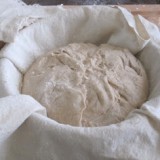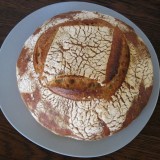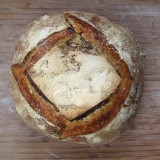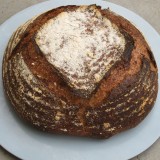
The failure of our toaster was caused by a break in the heating wire. Following these instructions, I attempted to mend the break, but it was in an awkward location and, like most objects these days, the toaster was not built to be fixed.
Disassembling the toaster laid bare the flaws in the design of all toasters. The heating wire (called nichrome wire–short for nickel-chromium) is fragile and extremely vulnerable to an errant bread crust.
I vowed to find an alternative and remembered seeing non-electric toasters that people used to use back in the 1920s when our house was built. These types of toasters have not died out entirely. Most non-electric toaster designs look like the one above. Some Googling also led us to an innovative looking non-electric toaster called the DeltaToast.
Counter-intuitively, all of these simple stove top toasters coast about twice as much as electric toaster, at least in the US. This leads me to my question for you, our dear readers. Have you used a non-electric toaster? How do they compare to electric toasters?
Note from Kelly:
I noticed that the stove-top or pyramid toaster seems to live on in Australia and New Zealand, judging by the number of businesses I found selling them there. The toasters were also much more reasonably priced than they are here– but shipping to the US was crazy expensive, scudding that possibility entirely. So I’m particularly interested in responses from readers in these countries. Who is buying and using them?
Also, there are many antique stove-top toasters available on Etsy for about ten to twelve bucks, but they’re all rusty and worse for wear.





You can find similar tools by looking up “Camp Stove Toaster” on Amazon.
We’ve done that, but the camping toaster is a flimsy thing, just some wire supports on plate, and we’ve found commentary saying it does not hold up and does not toast particularly well. Basically, it’s good enough for camping, but not at home.
You can toast by just laying bread down flat in the hot cast iron skillet, have to flip to do both sides!
Or best of all use a toasting fork, long handled mini pitchfork thing, to hold the bread up to the fire in the fireplace, have butter ready and eat huddled around the hearth!
That reminds me of my hiking trips up in the Norwegian mountains. We would build a fire, find some sticks for our bread to sit on, and even though it took quite some skill to get it toasted evenly , it was very delicious.
…on the same trip we’d also successfully made toast by using three candlelights! Ahh the outdoors really makes you feel creative
You can get amazingly creative while camping, yes–and the added benefit is that everything tastes good!
Oh! I’ve always wanted to make toast with a toasting fork, huddled by a fire. We don’t have a fireplace, and couldn’t use one if we had one because of air quality issues. Someday I hope to live somewhere where I can have a little fire and do things with it like toast muffins. And yes, the skillet is a possibility.
My great aunt had a cast iron stove converted to burn gas. It was on all the time and provided the heat for the cavernous kitchen. It also made the best toast of all time and space.
My father would slice off 1/2″ pieces of my great aunt’s white bread and put it flat directly on the cast iron top until one side was seared. I mean really seared. Then he’d flip it and do the other side. By the time it was done, it was super crunchy, hot enough on one side to instantly melt the butter, soft inside and, overall, just perfectly warm enough to enjoy.
I would give my right arm and my husband’s left one to have a stove like that! I can’t tell you the wonderful homey and unforgettable things that came out of it!
This might be what you are looking for and it’s only $16.
http://www.fantes.com/catalog/product/view/id/5717/s/brustolina—la-gratella-graticola-tostapane-stainless-steel-stovetop-toaster/
Here is a description of the ways you can use it.
http://www.laweekly.com/squidink/2012/10/16/q-and-a-with-faith-h-willinger-chef-author-patron-saint-of-the-tostapane
Thanks, Chris! This seems like a likely solution. And that store is full of tempting cooking toys. Also, I love that article–her evangelical fervor for the tostapane. I also like saying tostapane.
We have never owned a toaster in our adult life. We just put bread dry or buttered on a cast iron pan or a flat griddle, or use the broiler if making a lot. IMO, those slice toasters make horrible toast and take up way too much space/ are too hard to keep clean.
Yes! There is a whole school of skillet toasting, and I totally respect the common sense and minimalism behind it. Meanwhile, toast connoisseurs say that the advantage of stove top toasters over both electric toasters and the skillet method, is that they allow the bread to toast on the outside, but not to dry out on the inside, resulting in tastier toast. I’m not sure if there is anything to that or not. Do you have any thoughts?
In Venezuela every home has a budare, which is a sideless pan for making arepas, Venezuela’s answer to the tortilla. In our house the budare does double duty for me as a toaster. There are two tricks for ending up with tastier toast – crisp on the outside but not dried out inside. One is to let the budare (or pan) heat up well first, just like searing meat, the outside crisps up too fast for the inside to dry out. The other is to start with frozen bread, which I often do because I can’t eat a loaf of bread fast enough for it to stay fresh. Anyway, I’ve never missed having a toaster – there’s a bit of kitchen equipment I dream of acquiring when I have a real kitchen again, and I eat toast pretty much every day, but a toaster interests me not.
Ah, toast! Since I love it so much I have several types of toasters. A ‘normal’ modern one, an old electric one from the 1920’s with the doors that flip out on either side, and several stove top ones. One of the stove top ones is from the ’20’s and very well made. It belonged to my mother. The 2nd one is a camp fire fold up one that was well made back in the ’70’s. Which one do I prefer? The one with the flip out doors as I can control how dark/light I want it. Why am I using my more modern chrome Hamilton Beach one? Well, it seems that I still multitask too much and tend to burn things up, and those other ones could start a fire if unattended. But the HB one has lasted me for nearly 15 years so I consider myself lucky to have found a good one. I bless it and say ‘thank you’ every time I drop my bread in. I would positively hate to have to find one that works as well. Instead I would go back to using the others.
My suggestion is to keep checking the thrift stores and yard sales. The older ones are made to last.
As a reader from New Zealand I can say that although it would be rare to see someone using one of these in the home they are very popular with the camping set! Whether it be over an open fire or on a gas BBQ, you got to have your toast for breakfast…
What about a fish grilling basket?
https://duckduckgo.com/?q=fish+grilling+basket
I have definitely used the toaster illustrated at the top of this post. I just can’t remember exactly where in New Zealand or Australia. I do recall it works well but requires close attention. I’m easily distractable so pop up toasters suit me better.
My parents had one of the stove top toasters and we used it on occasion up until the 60s when my husband and I took it to use on our honeymoon camping in the Smokey Mountains. Really wish I had it today as our 2nd hand toaster is starting to go. Might have to try the cast iron skillet after the bacon and eggs are done – seems like grease left from the bacon might be a tasty addition.
Toasting thin soft white bread is a plus. But,…the homemade grain bread my spouse makes does not require toasting. We cut it with a hacksaw and usually soak it in soup or stew to soften it. So a stove top toaster for bread is not in our emergency prepping gear. We have better luck making tortillos and making meat wraps with them. Wonder if a square cheese grater would work the same for toasting.
Hmmm?
I have no electric toaster as we are “off grid” and we currently use the cheap camping one…it works…ok, but the flimsy nature of it leaves me feeling empty. Strange I know.
I have searched…as you have for alternatives and come up with nothing revolutionary.
Maybe it’s because there is no complicated doomahicky involved that we feel “there must be a better way”
Just maybe a pan on the stove, or a pyramid to rest the slice on is just about the acme of the potential…
Then again…maybe a little wind up rig that turns the toast around and around…or maybe…hahahaha.
Humans…we are never satisfied.
Though I would be happy if I could find a cast iron version of the cheap camp toaster…something with some heft.
MAN TOAST!
Keith, you made my day. I’m definitely in the “there must be a better way camp.” Kelly argues for the pan. I’m of course the member of the household who wants the sous vide equipment. Maybe there’s a camp version of that!
I have a lightweight version I use for camping. Works on my camp stove and/or fire. Great toast and easy to use and clean!
Buenas tostadas! Very cheap in Argentina. http://www.bazzartotal.com/fotos/5847.jpg
Another contender!
Hi guys,
I’m Australian- I think that our penchant for barbecuing and camping, cooking over fires etc explains why these kind of toasters are sold more in Australia. I wouldnt say the vast majority of households have them, it in a minority, but my family that live rurally tend to have them ( more the camp toaster style than anything)- and we call it bush toast! I’ve been meaning to get myself one to toast bread on my wood stove, actually.
Thanks for the insight, Alex!
Actually the top of my old Rocket Mass Heater made great toast, but when I built the permanent house there was no room for it. (we even used to roast chickens up there…made a tinfoil lid for the steel drum..made a great roast chicken…AND the tinfoil hat kept the Feds mind control efforts at bay!)
Hi there, In Chile, where I live, we have a very simple stove-top toaster, it is also cheap, and I could imagine making one is not that hard, here is a link for you
http://www.easy.cl/easy/ProductDisplay?mundo=1&id_prod=59878&id_cat=0&tpCa=4&caN0=4174&caN1=100&caN2=205&caN3=572
Its only 3 dollars..
Also these work very well, specially if you don’t have such a huge family, since you can only fit a couple of slices at a time.
Gracias! That looks very similar to the Tostapane.
The Tostapane looks a lot like a square version of a heat diffuser* that goes under a pan, plus a grill on top. I wonder if you could just set the bread on the diffuser? I’m staying with family for the holidays, but will experiment when I get home.
*e.g. http://www.amazon.com/Norpro-144-Heat-Diffuser/dp/B0000X6ESO/ref=sr_1_1?s=home-garden&ie=UTF8&qid=1419921130&sr=1-1&keywords=heat+diffuser
A maker I once knew made 3 single-slice toasters out of coffee cans and wire for our community kitchen’s gas range. I think they were made something like this: coffee cans were cut down to 4-6 inches tall, ends cut out into an open cylinder, a few holes cut around top perimeter, wire wrapped through holes and across opening to create a horizontal screen for the bread. Use on stove burner; bread must be watched closely and flipped. Other than the occasional burnt toast, these toasters worked well, lasted many years, and were pleasingly low-tech and homemade from cheap materials.
That’s cool! Thanks, Sharon.
Pingback: 037 Reinventing the Toaster | Root Simple
Broken toaster? or just need a cheap stove top version? My grandma and aunts used to bend a wire coat hanger so you could put in on the burner and rest the bread on top of it. Works like a charm. Pop loved it so much he never bothered to buy a toaster.
I just googled it and found this
http://sarahgignac.com/food-and-wine/my-new-toaster/